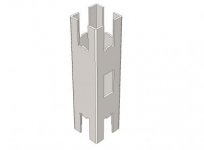martin_05
Hot Rolled
- Joined
- Mar 11, 2009
- Location
- Valencia, CA, USA
I have this project where we would have to make a few hundred parts that look like this:

This is mild steel tubing, 2 x 2x 0.120. I also have some parts that are made from 0.060 tubing.
I am very tempted to outsource this to someone with a laser tube cutter. I got a couple of quotes, one is ridiculous and the other can't deliver for many weeks. I won't even mention the folks who, two weeks after submitting an RFQ, can't be bothered to get back to me.
As a side comment, this is a persistent problem with US manufacturing. If I send 50 quotes to companies in China I get quotes back from all 50 of them (and sometimes a few more!) overnight or in a couple of days. In the US you are lucky if people get back to you in a week, if at all. This is truly frustrating.
Anyhow, it looks like we are going to buy the tubes pre-cut to length and just machine them on our VF-2 (8100 RPM spindle).
I am looking for ways to speed-up the cycle time per part.
Our tooling for steel is AlTiN coated, 4 flutes. I don't have a problem buying new cutting tools for this job if they would make a significant difference in cycle time.
The large slots are roughly 1 x 2 inches. All inside corners will be OK if we use a 1/8 in end mill to finish them.
At this point the strategy is to use the largest tool available (I think it is 1/2 in) to open the holes and then switch to 1/8 to finish the corners. It could make sense to go 1/2 -> 1/4 -> 1/8. Not sure yet. I'll be able to run some tests with scrap pieces towards the end of the week.
My thinking is that the opening of the hole goes slower because it is full radial engagement at the full thickness of the part. I am looking at about 3600 RPM and 40 IPM for roughing the initial slot.
I can then switch the same 1/2 endmill to a radial engagement of, say, 0.050 in and speed up to 4000 RPM and 65 IPM cutting speed. I could probably increase that to 0.100 in engagement and run at 50 IPM, this might be faster.
The corners is where I really have to slow down. For the 1/8 endmill I am calling out 8100 RPM (maxed out) and about 8 IPM, if that.
Another part has a 0.140 slot, about one inch long. This will be be slow. Not sure what tricks I can pull on this one other than buying a new cutter that allows me to go faster.
I'd appreciate any feedback (good, bad or ugly) on the above).
Thanks,
-Martin

This is mild steel tubing, 2 x 2x 0.120. I also have some parts that are made from 0.060 tubing.
I am very tempted to outsource this to someone with a laser tube cutter. I got a couple of quotes, one is ridiculous and the other can't deliver for many weeks. I won't even mention the folks who, two weeks after submitting an RFQ, can't be bothered to get back to me.
As a side comment, this is a persistent problem with US manufacturing. If I send 50 quotes to companies in China I get quotes back from all 50 of them (and sometimes a few more!) overnight or in a couple of days. In the US you are lucky if people get back to you in a week, if at all. This is truly frustrating.
Anyhow, it looks like we are going to buy the tubes pre-cut to length and just machine them on our VF-2 (8100 RPM spindle).
I am looking for ways to speed-up the cycle time per part.
Our tooling for steel is AlTiN coated, 4 flutes. I don't have a problem buying new cutting tools for this job if they would make a significant difference in cycle time.
The large slots are roughly 1 x 2 inches. All inside corners will be OK if we use a 1/8 in end mill to finish them.
At this point the strategy is to use the largest tool available (I think it is 1/2 in) to open the holes and then switch to 1/8 to finish the corners. It could make sense to go 1/2 -> 1/4 -> 1/8. Not sure yet. I'll be able to run some tests with scrap pieces towards the end of the week.
My thinking is that the opening of the hole goes slower because it is full radial engagement at the full thickness of the part. I am looking at about 3600 RPM and 40 IPM for roughing the initial slot.
I can then switch the same 1/2 endmill to a radial engagement of, say, 0.050 in and speed up to 4000 RPM and 65 IPM cutting speed. I could probably increase that to 0.100 in engagement and run at 50 IPM, this might be faster.
The corners is where I really have to slow down. For the 1/8 endmill I am calling out 8100 RPM (maxed out) and about 8 IPM, if that.
Another part has a 0.140 slot, about one inch long. This will be be slow. Not sure what tricks I can pull on this one other than buying a new cutter that allows me to go faster.
I'd appreciate any feedback (good, bad or ugly) on the above).
Thanks,
-Martin


